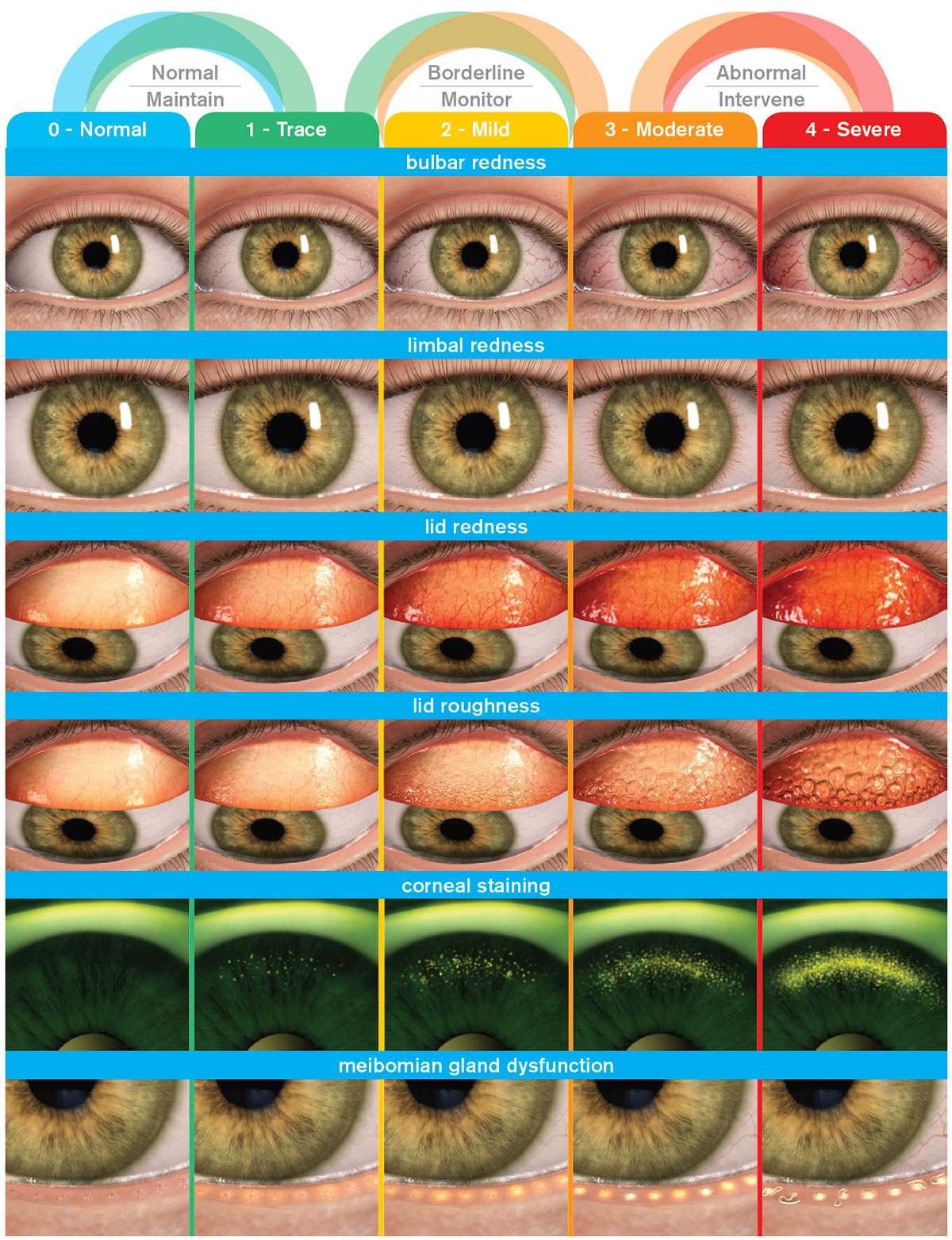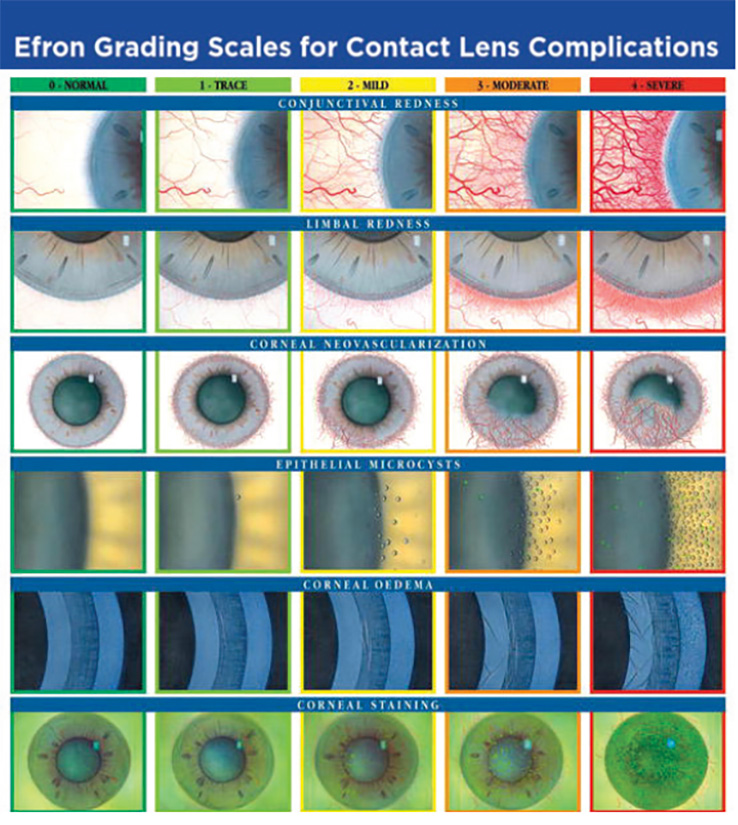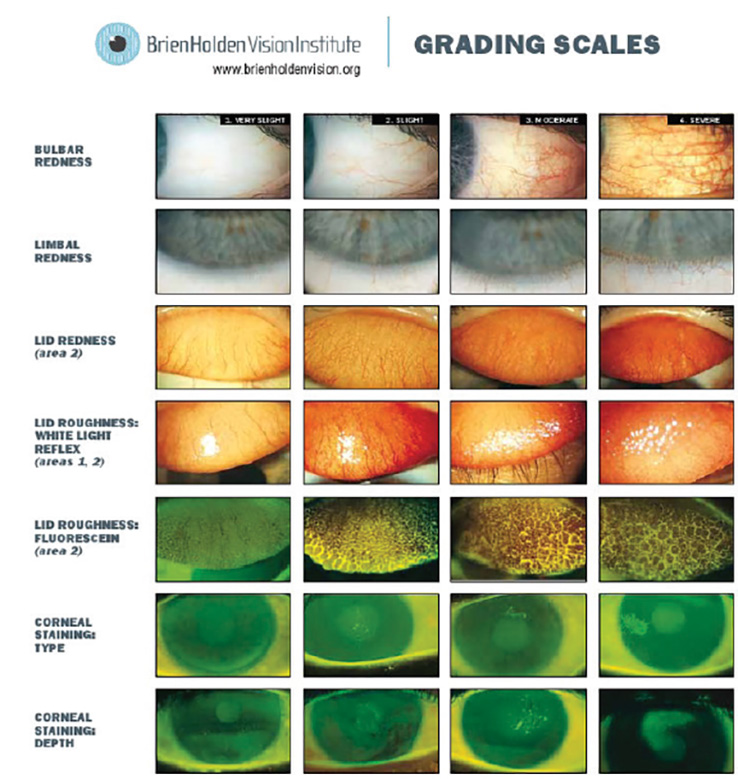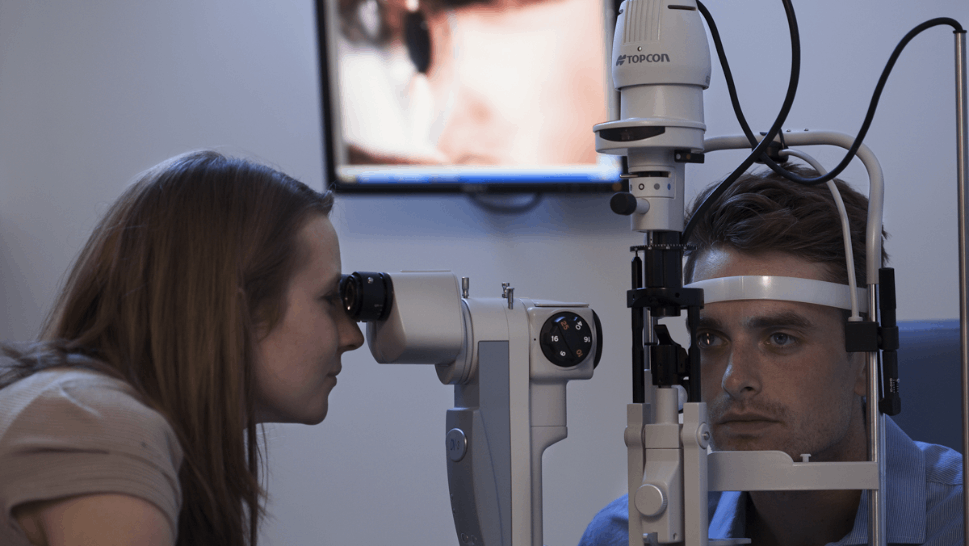What you need to know
- Grading scales are an essential tool for accurate and concise recording and monitoring of clinical changes to ocular tissues.
- Standardised scales are used to asses the severity of a wide range of conditions including those associated with contact lens wear.
- Whilst there are several grading scales available, it is important to select a single grading scale, to ensure consistency in recording keeping and to correctly monitor the progress of a clinical condition.
Types of grading scales:
Johnson & Johnson Vision Care Institute Clinical Grading Scale

An adapted version of the Efron grading scale, for easy chair-side reference. A guide to slit lamp illumination, staining, lid assessments and signs of oxygen deficiency is found on the reverse side.
Access grading scale here
The Efron Grading Scale

This grading scale uses pictorial images and provides a standard clinical reference for describing the severity of 16 contact lens complications with a grading of 0 to 4.
The Brien Holden Vision Institute (formerly CCLRU)

This grading scale uses photographic images for a range of conditions which may occur during contact lens wear.
- While there are differences in the number of reference images shown for these scales, all scales are intended to be used by using grades that range from 0, where no clinical action is required, through to grade 4, where clinical action is urgently required.
- Management will be based on how much the normal ocular appearance has changed, with a grade of 2 or less typically considered within normal limits. It has been recommended that, for maximum precision, recording of clinical signs using grading scales should be undertaken to the nearest 0.1 scale units and that a change in grading scale units of 1.0 is typically considered clinically meaningful, with Efron recommending a change of 0.7 units for the use of his scale
Clinical conditions:
The use of grading scales has been clinically validated for a variety of conditions such as:
- Bulbar Redness
- Limbal Redness
- Lid Redness
- Lid Roughness
- Corneal Staining
- Meibomian Gland Dysfunction
Although various systems are validated for clinical use, pictorial scales have been shown to be more reliable than photographic systems. Studies have also shown differences in precision and reliability between observers and between conditions.
Grading scales are a very useful clinical tool with a common language for improved accuracy, allowing direct comparisons, enhancing record keeping and are sensitive to monitoring changes. In addition, they can also be useful as an educational tool to help explain changes to the patient and so keep them fully informed.
Further reading
- Efron N, Pritchard N, Brandon K et al. How optometrists record corneal staining. Clin Exp Optom 2011;94:1 82-86.
- Efron N, Pritchard N, Brandon K et al. A survey of the use of grading scales for contact lens complications in optometric practice. Clin Exp Optom 2011;94:2 193- 199.
- Peterson RC and Wolffsohn JS. Objective grading of the anterior eye. Optom Vis Sci 2009;86:3 273-8.
- Schulze, M et al. The use of fractal analysis and photometry to estimate the accuracy of bulbar redness grading scales. Invest Ophthalmol Vis Sci 2008; 49(4), 1398-1406
- Efron N and McCubbin S. Grading contact lens complications under time constraints.Optom Vis Sci 2007;84:12 1082-1086.
- Efron N and Chaudry A. Grading static versus dynamic images of contact lens complications. Clin Exp Optom 2007;90:5 361-366.
- Wolffsohn JS. Incremental nature of anterior eye grading scales determined by objective image analysis. Br J Opthalmol 2004;88:11 1434-8.
- Efron N, Morgan P B, Farmer C et al. Experience and training as determinants of grading reliability when assessing the severity of contact lens complications. Ophthal Physiol Opt 2003;23:2 119-124.
- Efron N, Morgan PB and Jagpal R. The combined influence of knowledge, training and experience when grading contact lens complications. Ophthal Physiol Opt 2003; 23:1 79-85.
- Wolffsohn JS and Purslow C. Clinical monitoring of ocular physiology using digital image analysis. Cont Lens Anterior Eye 2003;26:1 27-35.
- Efron N, Morgan PB and Jagpal R. Validation of computer morphs for grading contact lens complications. Ophthal Physiol Opt 2002;22:4 341-349.
- Efron N, Morgan PB and Katsara SS. Validation of grading scales for contact lens complications. Ophthal Physiol Opt 2001;21:1 17-19.
- Efron N. Grading scales. Optician 2000;219:5733 42-43.
- Efron N. Grading scales for contact lens complications. Ophthal Physiol Opt 1998;18:2 182-186.
- McMillan R, Stevenson L, Ferguson L et al. CL record cards: their use with clinical grading scales. Optician 1998;216:5667 36-38.
- Efron N. Clinical application of grading scales for contact lens complications. Optician 1997;213: 5604 26-35.
- Efron N. Grading scales designed for practitioners. Optician 1997;213:5583 29.
- Terry RL, Schnider CM, Holden BA et al. CCLRU standards for success of daily and
- Bailey IL, Bullimore MA, Raasch TW et al. Clinical grading and the effects of scaling. Invest Ophthalmol Vis Sci 1991;32:2 422-432
- Efron N. Grading scales (Chapter 2). In: Efron N, Contact Lens Complications, Third Edition. Butterworth-Heinemann, Edinburgh 2012 (ISBN 978-1-4557-3774-1).
- Efron N. Grading morphs (Chapter 3). In: Efron N, Contact Lens Complications, Third Edition. Butterworth-Heinemann, Edinburgh 2012 (ISBN 978-1-4557-3774-1).
- Efron N. Grading scales for contact lens complications (Appendix A). In: Efron N, au. Contact Lens Complications, Third Edition. Butterworth-Heinemann, Edinburgh 2012 (ISBN 978-1-4557-3774-1).
- CCLRU grading scales. In Contact Lenses, 5th edition, edited by Phillips AJ and Speedwell L, Butterworth-Heinemann, Oxford, 2006 (ISBN 978-0-7506-8818-5).

